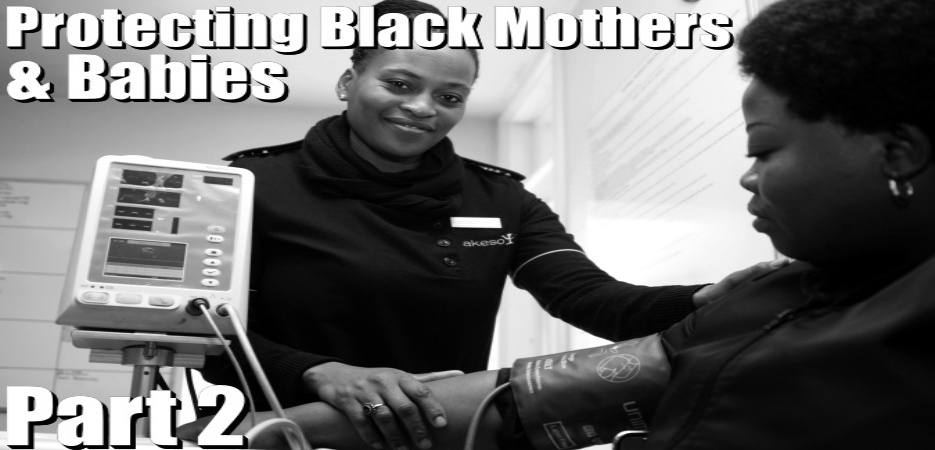This article is the second of two parts discussing the terrible outcomes of pregnant African American women and their babies. I begin by, again, summarizing the problems. However, it is important to state that neither article is written as the answer to what are complex, generational problems but simply a report of known facts of the problems, and a review of the literature of what may be some potential answers.
Review
African American “…women are three to four times more likely to die of pregnancy-related complications during childbearing and have greater pregnancy losses of 2 to 3 times higher e. g. miscarriages, stillbirths, and prematurity than any other ethnic group in the US. This continues even when compared to other women of color from African and Caribbean nations.” (Part I)
Additionally, many of the chronic diseases e. g. type 2 diabetes, hypertension, cancers, overweight and obesity, and more, are also higher in this demographic than in other American populations. When corrected for higher education and socioeconomic levels, these abnormal health outcomes remain. Furthermore, even if Black women have good prenatal care, the outcomes are unchanged. (1)
In the first article I identified three conditions that may contribute to the problems: overweight and obesity, a toxic community environment leading to greater toxicity of its residents, and implicit bias. However, it cannot stop there.
Common Denominators
Traditional medicine teaches healthcare providers to identify a condition and to treat it based on the known parameters of that condition. Most of the time, when the conditions are known, this is possible and we apply the corresponding treatments for the expected cure, prevention and/or mitigation as much as possible. However, in the case of the known problems for pregnant Black mothers and their babies, these methods have not achieved any of the expected results.
Therefore, we need other means to look for common denominators that have not been fully examined. Moreover, are there things that can be done to achieve better understanding and results than what we have to date? The three potential contributors mentioned in Part 1 are not root causes of the problems but mediators of disease.
Functional Medicine (FM), the newest medical discipline in healthcare, is a patient-centric discipline and requires using the tools of identifying Antecedents, Triggers and Mediators (ATM) to help identify root causes and effects of ill health. FM teaches providers that they must be comprehensive in their understanding of patients, their genetics, family histories and traits, nutritional state, social positioning and lifestyles, and other aspects of patients’ lives as a means of being able to effectively treat them. This, therefore, is another way in which we may be able to look at this terrible 400-year-old health issue that needs answers – even from a simple overview article.
Antecedents
The word antecedent means “to go before,” and in this sense, we are looking for any factor(s) that precedes the known conditions and healthcare outcomes for pregnant Black mothers and babies. The most obvious common denominator of this problem is, of course, race. One may say, that’s easily understood, but is it? Another antecedent is time. It’s been four hundred years of the same problems for the same people. A third antecedent – one that is too often ignored – are the historical lack of the social determinants of health (SDOH) that Black Americans have never fully had.
Why are the SDOH an antecedent and so important? It is known that SDOH account for 80% of the occurrence of ill health (2). And the combination of these three antecedents are most likely causative as they are always present prior to conception. These antecedents, collectively, position Black women to be subject to the effects of the triggers (an event that causes other reactions) and mediators (perpetuates the reactions).
Generally, there are six main SDOH according to the Office of Disease Prevention and Health Promotion:
- Economic Stability
- Education Access and Quality
- Health Care Access and Quality
- Neighborhood and Built Environment
- Social and Community Context
Examining this list, one could conclude – incorrectly – that African Americans, in general, have all of these. We don’t? Herein is where the real issues begin to arise. The assumptions that we do, do not factor in: the form, how much, the availability, timing, completeness, how provided, location, application, provided by whom, etc.? Additionally, due to the SDOH’s lack for African Americans, it is directly contributory to the continued persistence of the mediators of human toxicity and implicit bias.
What’s missing? Social and economic stressors are known to contribute to diseases of despair: alcoholism, drug addictions and suicide. And historically, despair, in any form, has always been a constant companion of African Americans since slavery, and there’s never been a period in American history where we were free of it (3). In this sense, the “despair” is due to racial discrimination and implicit bias in every aspect of Black American lives: housing, jobs, economics, education, transportation, the legal system, law enforcement, food, etc.
Regarding racial discrimination and implicit bias, this may be the differentiator why, when comparing pregnant Black American women to women of color from other countries such as Africa or the Caribbean, they do not suffer the same pregnancy fate. African and Caribbean women do not suffer despair from racial oppression in their native countries – perhaps except S. Africa and Rhodesia.
Triggers
In this instance, conception is the trigger. As most know, pregnancy is a physiologic challenge to the health status of any women independent of race. It increases the demand on every organ of a women’s body 20 times of a non-pregnant state. And let’s not forget, the American Black women, health-wise, is already a time bomb.
Mediators
It is known that overweight and obesity are gateway conditions to most chronic diseases including but not limited to hypertension, type II diabetes, cancers, etc. Fifty-nine percent of African American women are obese (5, 6). Fat cells are a repository for toxins in the body. Toxins are a multiplier of disease events and severity, as they interfere with metabolic pathways and enzyme systems of cells making any underlying health conditions become manifest. Adding the lifelong emotional component of despair, is physiologically and psychologically overwhelming. Despair, long term emotional stress, and hopelessness adversely affect the heart, kidneys, adrenals and all endocrine glands, the brain, the immune and gastrointestinal systems, and psychological wellbeing.
Trying to correct underlying health issues during a pregnancy with or without SDOH is well beyond – too little, too late. This includes prenatal care. However, without the early intervention of the SDOH in childhood and prenatal care for any Black women is nearly a death sentence during the pregnancy.
Last, but not least, pregnant Black women are then placed in the hands of too many people who do not look like them and have little understanding of their lives, their plight and circumstances, and more often, have lifelong implicit bias. It is well known that implicit bias increases morbidity and mortality for African Americans: men, women, and babies. (4)
What to do?
Nothing written here is the answer but, hopefully, points people in the right direction. The following are all sound acceptable recommendations:
- Weight loss: I begin with this because it is within your control to do. You may need help, but it can be done and is a giant step in preventing these bad pregnancy outcomes.
- SDOH: This is far more challenging than the above. It means one needs to identify what the SDOH are in your community, and how to access and implement them now, not waiting for pregnancy for anyone.
- Toxic Environment: Attempt to identify if your community is recognized by the EPA as toxic. If so, then go to your healthcare provider to let them know your concerns.
- Implicit Bias: This is difficult to write about but if you are a pregnant African American this is necessary. Since our country isn’t prepared to retrain healthcare providers in this regard, Black women in childbearing years should look for healthcare providers that look like them.
- Non–Black Persons: To non-black Americans, you cannot be silent about what’s happening – ever again. Find a way to be a change agent for any oppressed people.
- Panel of Experts discussing this topic: 5 experts on the panel Protect Black Mothers: A Holistic Perspective of the Maternity Crisis (originally aired April 14, 2021): https://youtu.be/KOxtluHDDzY
Citations:
- Am J Public Health. 2017 May; 107(5): 644–645. Published online 2017 May. The US Black–White Infant Mortality Gap: Marker of Deep Inequities Russell S. Kirby, PhD
- Health IT Analytics. Social, Behavioral Data Must Be Included in EHRs, Nurses Say. Jennifer Bresnick. Sept. 14, 2015. https://healthitanalytics.com/news/social-behavioral-data-must-be-included-in-ehrs-nurses-say.
- Walker, R. W. Black Health Matters; Square One Publishers, June 2021.
- Physician–patient racial concordance and disparities in birthing mortality for newborns. Brad N. Greenwood, Rachel R. Hardeman, Laura Huang, et al. September 1, 2020 117 (35) 21194-21200; 2020.
- Overweight and obesity statistics 2021, By SingleCare Team, Updated on Jan. 21, 2021 Medically reviewed by Karen Berger, Pharm.D. https://www.singlecare.com/blog/news/obesity-statistics/
- CDC: Adult Obesity Facts. https://www.cdc.gov/obesity/data/adult.html














